Report 2: Research, Opportunities and Concepts
From DDL Wiki
(→Pugh Chart) |
|||
| Line 11: | Line 11: | ||
*Yes: 35.7%<br /> | *Yes: 35.7%<br /> | ||
*No: 60.7%<br /> | *No: 60.7%<br /> | ||
| - | *No, but I am planning to purchase on: 3.6% | + | *No, but I am planning to purchase on: 3.6%<br /> |
Note: 39.3 percent of respondents indicated that they either own or plan to own a bicycle. This demonstrate that there is a relative large market for bicycle and its accessories on a college campus.<br /> | Note: 39.3 percent of respondents indicated that they either own or plan to own a bicycle. This demonstrate that there is a relative large market for bicycle and its accessories on a college campus.<br /> | ||
| Line 58: | Line 58: | ||
Note: The top seven choices concluded from this survey are 1) Charge indicator 2) Power storing capacity 3) Self-powered generator 4) Adjustable brightness 5) Detachable feature 6) Light-sensitive sensor 7) Turn signals<br /><br /> | Note: The top seven choices concluded from this survey are 1) Charge indicator 2) Power storing capacity 3) Self-powered generator 4) Adjustable brightness 5) Detachable feature 6) Light-sensitive sensor 7) Turn signals<br /><br /> | ||
| - | In conclusion of our surveys, we were able to indentify the need and want of a bicycle light set. In which reassured the direction of a generator powered bicycle light set is not only a engineered product but also a marketable product. In addition, we collected valuable information regarding the some of the new features that can be integrated in to the generator powered bicycle light set. <br /> | + | In conclusion of our surveys, we were able to indentify the need and want of a bicycle light set. In which reassured the direction of a generator powered bicycle light set is not only a engineered product but also a marketable product. In addition, we collected valuable information regarding the some of the new features that can be integrated in to the generator powered bicycle light set. <br /><br /> |
====Observations==== | ====Observations==== | ||
When observing the other bicycle light set in the market we have identified few technologies that are currently use by the competitors. We will discuss each of the following below. <br /> | When observing the other bicycle light set in the market we have identified few technologies that are currently use by the competitors. We will discuss each of the following below. <br /> | ||
| - | ''' Battery Powered''' | + | ''' Battery Powered'''<br /> |
[[Image:Bikebattery.jpg]]<br /> | [[Image:Bikebattery.jpg]]<br /> | ||
| + | Wide use technology, depending on the specification of the components it can range from $4 to $600. Since, we are targeting the environmentally awared clients we would not consider this as a direct competition.<br /><br /> | ||
| - | '''Hub Dynamo''' | + | |
| + | '''Hub Dynamo'''<br /> | ||
[[Image:Bikehub.jpg]]<br /> | [[Image:Bikehub.jpg]]<br /> | ||
| + | This technology integrates its dynamo into bicycle's front wheel. It requires a total replacement of front tire. However, it does have the advantage of not creating any additional friction for pedaling. Due to the replacement of major parts of bicycles, this technology usually cost between $100 to $300. Since our bicycle light set is targeting the price range of $20 to $100. We are competeing for different segments of the market.<br /><br /> | ||
| + | |||
| - | '''Bottom Bracket Dynamo''' | + | '''Bottom Bracket Dynamo'''<br /> |
[[Image:Bikebottom.jpg]]<br /> | [[Image:Bikebottom.jpg]]<br /> | ||
| + | This technology is very similar to our technology "Bottle dynamo". The only major difference is that its generator is mounted between the bottom bracket (where you padal) and your rear wheel. Its roller make contact with the surface of the wheel rather than the profile. This technology is in direct competition with ours. However, it also experiences the same failure modes we do. Therefore, if we can improve our product we can significantlly gain market shares.<br /><br /> | ||
| - | |||
| - | |||
| - | |||
| + | '''Magnet Dynamo'''<br /> | ||
| + | [[Image:Bikemagnet1.jpg]][[Image:Bikemagnet2.gif]]<br /> | ||
| + | This is a different technology where its generator is not powered by any contact force. Rather, a magnet is mounted on the rim of the wheel and everytime it moves pass the generator it pushes the built-in magnet in the generator to rotate. This product is simple and cheap, however it is not fully develope yet. If we can incorporate this in to our product we can reduce the pedaling friction caused by the generator and wear due to the roller. <br /><br /> | ||
Revision as of 00:04, 9 March 2007
Contents |
Research, Obervations, Design, and Opportunities
Research
After analyzing the current product, we decided to further study on what the user really want and need from a bicycle light set. To determine this we gathered our data through a survey that was distributed on a college campus, Carnegie Mellon Unversity. In this section we will discuss the information we gathered, and our observation through these information.
Survey
By March 06, 2007 we had 84 survyees completed our surveys. 100 percent of our surveyees are between the age group of 18 to 27 years old. About one third are females and two third are males. The followings are the few major questions that we had gain insightful information from.
1. Do you currently own a bicycle? (multiple choices, 84 respondents)
- Yes: 35.7%
- No: 60.7%
- No, but I am planning to purchase on: 3.6%
Note: 39.3 percent of respondents indicated that they either own or plan to own a bicycle. This demonstrate that there is a relative large market for bicycle and its accessories on a college campus.
2. How much did (will) you pay for your bicycle? (multiple choices, 84 respondents)
- $0-$50: 0%
- $51-$100: 10.7%
- $101-$150: 32.1%
- $151-$200: 14.3%
- $201-$300: 7.1%
- $301-$400: 3.6%
- $401-$600: 3.6%
- $601+ : 0%
- I never nor plan to own a bike: 25%
- Other: 3.6%
Note: 28.6 percent would or had purchased a bicycle for more than $151. This demonstrated that there is the financial capability of the students to purchase bicycle accessories.
3. Do you (plan to) ride your bike at night? If so, how often? (multiple choices, 84 respondents)
- Almost everyday: 10.7.%
- Few times a week: 14.3%
- Few times a month: 14.3%
- Few times a year: 13.7%
- Once every few years: 0%
- I don't nor plan to ride a bike: 47.0%
Note: A quarter of the respondent indicated that they ride their bike at least few times a week at night. This is a strong support to prove the need of a bicycle light set in the bicycle accessories market.
4. How appealing and feasible (willing to pay for) are the following features on a bicycle light set to you? (rating scale 1-5, 81 respondents)
- Self powered (power generates as you pedal): 3.92
- Power storing capacity (light can still be on even when not pedaling: 3.89
- Detachable feature to use the headlight as portable flashlight when need to or anti-theft reason: 3.68
- Compatible to charge the light with outlets: 3.50
- Ability to provide power output to charge electronic devices (ie. ipod): 3.67
- Charge indicator (display whether if the batter is fully charged or out of battery): 3.96
- Light-sensitive sensor (to turn on/off the lights): 3.68
- LED light bulbs: 3.54
- Florescent light bulbs: 3.00
- Radio: 2.93
- Digital Clock: 3.18
- Compass: 3.25
- Multiple flashing mode: 3.18
- Adjustable brightness feature: 3.70
- Steering handel mount headlight: 3.21
- Top of front wheel mount headlight: 3.30
- Adjustable light positions: 3.54
- Turn signals: 3.70
- Electrical horn: 3.11
Note: The top seven choices concluded from this survey are 1) Charge indicator 2) Power storing capacity 3) Self-powered generator 4) Adjustable brightness 5) Detachable feature 6) Light-sensitive sensor 7) Turn signals
In conclusion of our surveys, we were able to indentify the need and want of a bicycle light set. In which reassured the direction of a generator powered bicycle light set is not only a engineered product but also a marketable product. In addition, we collected valuable information regarding the some of the new features that can be integrated in to the generator powered bicycle light set.
Observations
When observing the other bicycle light set in the market we have identified few technologies that are currently use by the competitors. We will discuss each of the following below.
Battery Powered
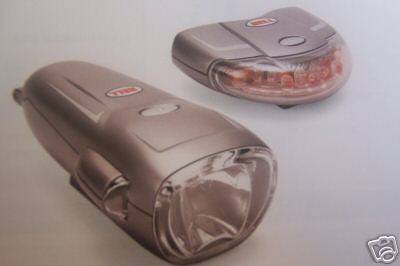
Wide use technology, depending on the specification of the components it can range from $4 to $600. Since, we are targeting the environmentally awared clients we would not consider this as a direct competition.
Hub Dynamo
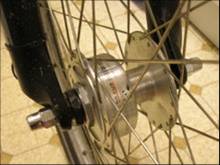
This technology integrates its dynamo into bicycle's front wheel. It requires a total replacement of front tire. However, it does have the advantage of not creating any additional friction for pedaling. Due to the replacement of major parts of bicycles, this technology usually cost between $100 to $300. Since our bicycle light set is targeting the price range of $20 to $100. We are competeing for different segments of the market.
Bottom Bracket Dynamo
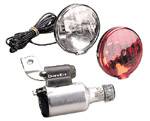
This technology is very similar to our technology "Bottle dynamo". The only major difference is that its generator is mounted between the bottom bracket (where you padal) and your rear wheel. Its roller make contact with the surface of the wheel rather than the profile. This technology is in direct competition with ours. However, it also experiences the same failure modes we do. Therefore, if we can improve our product we can significantlly gain market shares.
Magnet Dynamo
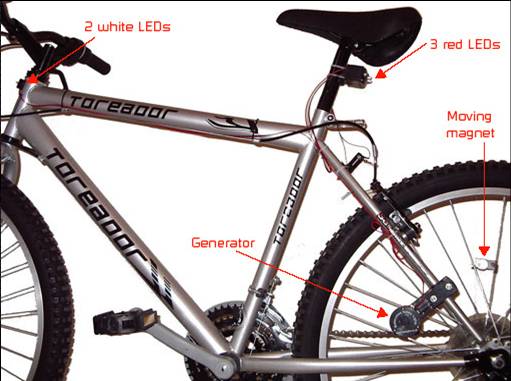
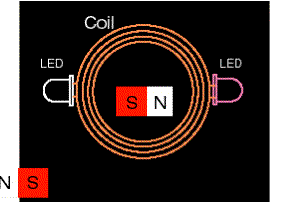
This is a different technology where its generator is not powered by any contact force. Rather, a magnet is mounted on the rim of the wheel and everytime it moves pass the generator it pushes the built-in magnet in the generator to rotate. This product is simple and cheap, however it is not fully develope yet. If we can incorporate this in to our product we can reduce the pedaling friction caused by the generator and wear due to the roller.
Design Problems
Insights and Opportunities
50 Design Concepts
Installation
1. User manual
2. Wire organizing device (straps)
3. Provide simple installation tools
Mechanical
4. Use magnetic force to turn the generator
5. Low friction bearings
6. High traction roller (Different material: Rubber or metal; Different shape)
7. Transfer torque from the chain
8. Transfer torque from the pedal crank
9. Transfer torque from the wheel shaft
10. Adjustable spring for generator to provide efficient contact with wheel
11. Lightweight materials for generator
12. Rubber washers to reduce vibration noise
Electrical
13. Storing capacity (built-in rechargeable battery pack)
14. Voltage regulator (zener diode is an option)
15. Options to use over the counter batteries
16. Full circuit wiring (does not use the frame as a conductor)
17. Divide the power output to both front and rear lights
18. Deliver more current to front lights when in motion, and to the rear lights when stopped
19. Charge output feature
20. Light-sensitive sensor (to turn it on/off)
21. Multiple flashing modes and control switch
22. Multiple brightness levels and control switch
23. Power on/off switch
Mounting
24. Able to mount device on bicycles with shocks
25. Able to mount device on the steering handle
26. Universal mount for the generator
27. Adjustable lamp positions
28. Able to detach device with quick release switch
29. Mount the generator on top of the front wheel
30. Special mount for bicycle with basket in the front
31. Velcro mount
32. Magnetic mount
33. Slip-on mount
Lighting
34. Multiple LED light bulbs for extra brightness
35. Florescent light bulbs
36. Maximize ground coverage through angled arrangement of lights
37. Turn signals
Features
38. Charge indicator
39. Incorporate a compass on the device
40. Detachable to use as flashlight
41. Can be charge through power outlet
42. Anti-theft design
43. Warranty
44. Radio
45. Electrical honk
46. Digital clock
Exterior
47. Water resistant design
48. Fog resistant lens cover
49. Aerodynamic design
50. Different color selections
Top Design Concepts
Design One | Power Storage Ability
Problem The generator stops when the bike is not in motion, cutting off the power delivery to the light. Thus putting the driver's safety at risk when he/she is about to cross a road in the dark.
Solution Power is harnessed from the generator to recharge a battery pack, and then electricity is delivered from the battery pack to the light.

Design Two | Fully Wired Closed Circuit
Problem Traditional generators use the bicycle frame to ground the circuit. However, many modern bicycles use composite materials that do not conduct electricity.
Solution A closed circuit is created with wires connecting to both the positive and negative terminals of all the components.

Design Three | Detachability, Charge Indicator, Power Button
Problem From our market survey, these features are preferred by most users.
Solution A power button and a charge indicator is added to the light. The light can be mounted on a fixture that is securely attached to the bicycle frame.

Design Four | Chain-Mounted Generator
Problem Traditional dynamos wear out tires and are prone to slip in water and debris.
Solution Although mechanically challenging, mounting the generator on the chain will solve the above problems, and in addition, maintain a stable voltage output.

Design Five | Detachability, Charge Indicator, Power Button
Problem It is difficult to guess a rider’s intended direction of turning, even more difficult in the dark and in a distance.
Solution Divert power from the system to power up turn signal lights attached to multiple locations of bicycle.

Experimental Design Concept
After receiving feedback from the professor and the class during our presentation, we gained valuable insight on where to take our next step. In addition to our original proposed design concepts, we came up with a novel idea that was inspired by a question raised in class by a mechanical engineering student.
The following design concept is based on the existing technology of rotating a magnet with another magnet. This design we are proposing will implement that technology, in a more efficient and powerful way. For each rotation of the bicycle wheel, the rotating magnet will rotate multiple revolutions. The magnet-and-coil assembly will generate enough electricity to charge up the battery pack.


